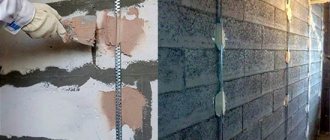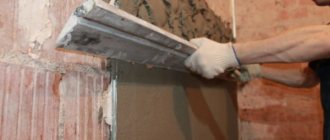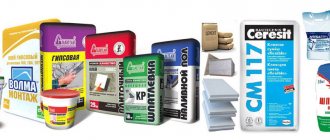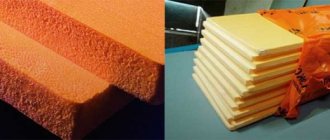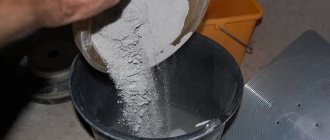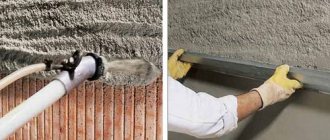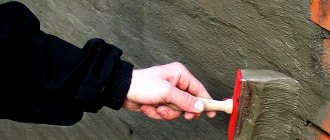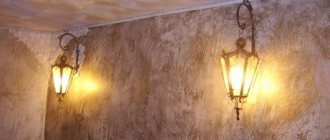What are string beacons for plaster, how to install them and how to make them yourself?
Leveling walls with plaster is carried out not only during construction, but also during repairs. Smooth plaster is the basis for any finishing. Beacons are used for alignment. Several types of them have been developed - mortar, profile metal, mobile, mortar with a gasket, sliding and string.
Purpose of string beacons
They use string beacons for plaster when performing leveling rough plastering work. If the base surfaces in a room or on a facade have large differences or you need to obtain a high-quality surface, you cannot do without auxiliary landmarks. Such landmarks are beacons - even strips or profiles, the surface of which forms an auxiliary plane, distinguished by its exact location in space. It turned out that plastering along beacons can be done using guidelines made of tensioned wire, based on which the applied mortar is usually leveled. These landmarks are called string beacons.
They are especially often used on long walls.
Advantage of string construction
Plastering on string beacons has several advantages over other options:
- it becomes possible to quickly reinstall and transfer to the next plastered surface;
- easy installation;
- no elements to be picked out and no need to seal deep and wide furrows;
- the trace of the string after its dismantling looks like a deep scratch; it becomes invisible after continuous putty and the following primer.
Types and design features
There is no classification of string beacons yet. This design in plastering appeared recently and became widely known thanks to the Internet. The main directions of design development are the development of convenient, reliable and easy-to-use stops and tensioners. The main working element of the string guide is a wire stretched between two fixing elements along the plastered base.
Of the two fixing elements, one is a kind of simple anchor, the second is more complicated, because it is used to tension the string. For tensioning, a bolted connection is used, which allows, when screwing or unscrewing, to change the length between the persistent elements fixing the string. The clamps are attached to the base using dowels or self-tapping screws, so they are reusable and removable. The design of the clamps also provides for adjusting the distance between the wire and the base.
string lighthouse base
stretched string
plaster roller under the lighthouse
The last (disposable) element of the string guide is a strip of hardened mortar - a kind of mortar beacon. It is designed to ensure that the tensioned wire does not change its configuration when a rule sliding along the top is supported on it. After tensioning the wire, apply a bead of mortar under it with a spatula, which quickly gains strength. The cross-section of the roller has the shape of a triangle, on one of the vertices of which a string rests.
Purpose of lighthouses
Beacons will allow you to create a perfectly flat surface.
When plastering any base, it is very important to obtain a perfectly flat surface. This will allow you to spend significantly less effort and time on finishing in the future, while getting an excellent result.
Painting, whitewashing, applying decorative plaster and gluing wallpaper should be done on a previously leveled surface that does not have any visible defects.
Use any suitable object for reference
To do this, for a long time, professional plasterers have been using various devices that serve as guidelines when applying and distributing the solution. These devices are called “beacons”.
Typically, any suitable material is used to make beacons: wooden strip, metal profile, small diameter pipe, etc.
The main condition is that this item is smooth, durable and easy to use. But perhaps the most technologically advanced and at the same time simple design is string beacons.
Advantages and disadvantages of string lighthouses
Like any device, string beacons for plaster, while having strengths, have disadvantages. Therefore, in some cases, a different design has advantages over them. In other cases, despite the disadvantages, string guidelines are chosen for plastering.
Pros:
- reusability;
- low cost;
- the ability to produce on your own;
- easy removal, small amount of subsequent surface editing (does not form a groove);
- gain in time;
- simplification of the formation of an auxiliary plane: you only need to level (or plumb) two (in more complex cases - three) strings;
- the ability to replace wire that has become unusable;
- reducing the minimum possible thickness of the leveling layer;
- You can install only two string beacons for plaster on long walls.
Flaws:
- the system is sensitive to random bends of the wire (any bending of the string affects the quality of the resulting surface), which is often difficult to correct;
- the presence of vulnerable spots - the thread may become clogged with a solution (the solution is to protect the fixing elements before using the solution, for example, with polyethylene);
- the possibility of corrosion of elements as a result of working with raw solutions (for fixing elements it is more rational to use stainless parts);
- unusual leveling technology, in which the rule is carried out in a horizontal direction (the cut solution tends to fly to the floor);
- complex and unusual installation process.
Installation features
Work begins with two strings, a screwdriver, pliers, a plumb line, a building level, a hammer and a wrench. A plaster mixture is used for leveling.
You will need standard fasteners:
- dowels and screws if you plan to level a concrete or brick wall;
- Only self-tapping screws for woodworking (on wood structures).
Beacons based on a string mechanism are installed taking into account the size rule: the distance between them should be less than the width of the leveling tool. This will improve the quality of work.
It must be taken into account that large surfaces are leveled in a different way (several string beacons should be installed for plastering walls).
The scheme in this case will be complex: the beacons are fixed along the perimeter (at a distance of up to 20 cm from each edge), in the center and crosswise. This will prevent the wire from sagging.
Consolidation process
Instructions for fixing beacons:
- Prepare holes for installing fasteners, taking into account the dimensions of the product.
- The beacons are fixed at a given level.
- Adjust the string mechanism. To do this, the opposite ends of the wire are twisted in different ways: clockwise and against its movement (by tightening the fasteners). At this stage, you need to make sure that the string is stretched as tightly as possible.
Beacon installation technology step by step
Main stages of fixing beacons:
- Work begins by marking the wall. At the same time, its height and length are taken into account. Based on such data, the locations of beacons and their number are determined.
- After fixing the leveling devices, check their position relative to each other. At the same time, the distance between the beacons is estimated. To level the wall, the rule must pass along the strings without moving anywhere (neither up nor down). This will allow you to get the best result. It is not enough to install beacons only at opposite ends of the wall. There will be too much distance between them, as a result the rule will not be able to move along the string mechanism.
- Align the strings. To do this, use a building level or plumb line. If the strings cannot be accurately adjusted at this stage, the quality of the wall alignment will decrease. Indentations will appear as the wire hangs.
- Prepare a mixture that will be used to support the wire from the bottom side. A roller should be formed using a spatula. It is important to use a building level at this stage, otherwise the risk of changing the position of the string mechanism will increase. The surface of the rollers must be smooth.
Work begins on the condition that the leveling mixture has dried. Otherwise, the rule will push through the support roller, which will lead to bending of the wire.
Which wire to choose
For string beacons, any elastic wire, made of stainless material or with a durable insulating coating, is suitable. More often, stainless steel wire made in accordance with GOST 9389-75 is used. Copper-plated (ER70S-6) wire with a diameter of 1.2 mm is suitable for semi-automatic welding. Corrugated wire left over from work on pulling electrical cables is suitable. Galvanized knitting wire is also used.
A thin cable can also be used as a string. The only drawback is that when pulling the rule, it wears out the working edge of the tool.
How can you replace beacons for plaster?
They can be made from the plaster itself. Naturally, there is no need to remove such products. Marking the wall and installing screws is carried out in the same way as described above. The level at which the plaster solution is applied are the caps of the mentioned fasteners. Press a wooden beam (board) between the heads of the screws and the wall, and fill the space between it and the unplastered surface with mortar.
It is recommended to enlist an assistant for such work.
Beacon installation technology step by step
Let's immediately outline the nuances. String beacons on the walls are installed horizontally. If the height of the walls is up to 2 m, it is enough to install two beacons. They are placed at a distance of 100-120 cm from each other (this distance depends on the size of the rule used). For high ceiling heights, three strings can be installed on the wall.
- First of all, we mark the wall using a tape measure and a level (we draw horizontal marking stripes and mark the location of the anchors).
- We install the clamp and tensioner on the base. If the base material is concrete or brick, fastening is done with dowel nails. If we are plastering a wooden surface, we use self-tapping screws.
- We fix one end of the string to the clamp. We attach the second end to the movable (adjusting) bolt of the tensioner.
- We tighten the wire by tightening the adjusting bolt with a suitable tool (screwdriver, screwdriver or wrench).
- We check the location of the string (distance from the wall) using a level or plumb line. We correct the position of the string using special anchor bolts or placing wedges under the wire. This stage is especially important.
- Mix the solution to create a support roller. Apply and level the plaster mixture with a spatula, forming a roller. Finally, we clean the top of the string from the solution.
- Let the plaster composition harden and begin plastering the walls.
installing the retainer
fasten the wire
string tension and adjustment
formation of a structural roller
The string can be dismantled after the solution has set. This is done in reverse order. The lighthouse elements are cleaned of any remaining plaster mixture, dried or reused. The string is rolled up for storage without kinks.
When tensioning the string, be careful not to over-tighten it (otherwise the wire may break). The tension should be tight enough without sagging.
Installation Rules
The process of installing beacons consists of marking the surface and attaching guides. The distance between separately installed strings should be equal to the width of the rule.
Installation procedure:
- String beacons are mounted on the walls approximately 30 centimeters from the ceiling and floor, on the right and left. One wall requires four metal fasteners and two strings. The corners are attached to brick and concrete with dowel nails, and to wood - with self-tapping screws.
- Then the wire is attached to the holes in the corners with nuts and bolts.
- The next stage is tight tension with a wrench. It is important that the string is tensioned as much as possible, but does not break!
- The plane is built using a level and a rule. To remove the vertical, additional screws are used. If everything is done correctly, the upper and lower strings will clearly pass along the plane and serve as a guide for the rest of the surface.
- The wire is pressed to the surface and coated with plaster so that there is no deflection while working as a rule.
- It is difficult to install string beacons the first time, but then the process goes much faster.
Expert opinion
Mezentsev Sergey Petrovich
Residential renovation and finishing specialist
Do not leave the screws that secure the guides in the wall. Over time, they can rust and stain the finish.
How to make string beacons for plaster with your own hands
In order to make a string beacon with your own hands, you will need two angles, two bolts with 10mm nuts, two dowel-nails or self-tapping screws (for example, a 75 screw and a 6x40 dowel), a wrench and pliers. In addition, wedges are needed (you can take the wedges used when installing windows). It is better to take dowels with ears so that they are securely fixed in the wall material.
wedge adjustment
A hole is drilled in the corners (in one shelf - for a bolt, in the other for a self-tapping screw). When installing a beacon, one shelf of the corner is pressed against the wall with a self-tapping screw, the other is positioned perpendicular to the base. With these shelves, the two corners holding the string should face each other.
homemade retainer
The end of the wire is wrapped (2-3 turns) around the bolt (under the head) and the tip is wrapped around the wire to secure it. The extra piece of the end is bitten off. The bolt is inserted into the hole in the angle, and a nut is screwed onto it on the other side. The other end of the string, not reaching the flange of the corner by about 5 cm, is bent, wrapped around the rod of the second bolt and secured to the head, like the first. The bolt is inserted into the hole in the angle and the nut is screwed on.
Manufacturing is also possible from a regular clamp. This is not the best option and we do not recommend using it.
When tensioning the wire, hold the bolt head with pliers so that it does not turn, and screw the nut with a wrench.
Do not forget that the wire can burst not only from high tension, but also as a result of manufacturing defects. Use protective equipment.
Setting up beacons - instructions
Plastering walls on beacons
Before placing beacons, you need to decide which of the above types is best to use.
- Metal profiles are universal. It is convenient to install them on the so-called “flat cakes”, i.e. do not completely cover them with glue, but form three or four supports for each profile. This is convenient and fast, especially if the wall has a very broken geometry and there are large differences. In this case, the metal profile perfectly holds the geometry and does not bend when plastered, which cannot be said about plastic beacons. It is better not to use them in such cases
- String analogues are suitable for leveling both relatively flat surfaces and walls and ceilings with large differences. The wire, stretched like a string, has sufficient rigidity and, after mechanical action on it, instantly returns to its previous position. Two or three formed supports (cakes) along the entire length will be more than enough for comfortable work
It should be noted that if you need to apply a minimum layer, then string technology will allow you to do this, which will significantly save the consumption of dry plaster. However, in small rooms this method is not advisable, only in areas longer than 2-2.5 meters.
- For small surfaces where you need to apply a minimum layer, you can use a homemade beacon - form it from plaster; it will not be hampered by minor defects and irregularities. But remember that the minimum value for one layer is 3 mm. When using this method, you can use methods from other technologies, for example, self-tapping alignment.
Let's start marking
Almost every wall looks like this
There are no strict requirements for the formation of beacons. Marking is also done at the discretion of the worker - he will do the plastering later. The main thing that is taken into account when applying markings is the length of the rule (a long and wide spatula).
1 The width of the plaster strip , which is limited by two beacon guides, should be less than the length of the rule by about 20 cm - 10 cm in each direction for the rule to move when leveling the plaster. If the length of the plasterer’s main tool is 2 meters, then the width of the strip is 1.8 meters, if 2.5 m, then 2.3 m, etc.
2 Start marking from the edge of the wall. Having retreated 10 cm, the first vertical line is drawn using a building level. From it, at a distance of the rule length minus 20 cm (see above), the next vertical is formed, etc. Similar actions are carried out until the end of the wall. If the last stripe turns out to be smaller, then so be it. The main thing is that the last vertical line is 10 cm from the edge or corner of the wall
This is the basis on which the entire scheme of beacons and their placement in the level will be formed.
There is no need to set the vertical level perfectly; small errors are acceptable - in any case, they will not lead to a violation of the perpendicularity of the wall relative to the floor.
3 Next, horizontal markings are made. Stepping back 5-10 cm from the floor level, beat off the bottom line. The upper horizon is formed in the same way. In the middle, you also need to make a similar marking - the distance from the floor level is taken arbitrarily, approximately in the middle of the wall.
It is clearly shown how the level is set approximately
The intersections of horizontal and vertical lines will be the control adjustment units for setting the plaster beacons to the level.
4 Depending on the material of the walls, take a drill or hammer drill and drill holes for dowel-nails at the intersection points - they will adjust the level of the profiles, when gluing them to glue, the latter will rest on them (touch)
For all drilled holes located at the edge or corner of the wall, duplicate holes must be drilled at a distance of 2-3 cm. Those. to the right on the right side of the wall and to the left on the left - this is necessary to attach the cord along which the level will be set.
5 The dowels are inserted, but the screws are not clogged, but are carefully twisted
6 The time has come to identify where the place is where the wall most collapses into the room where the plastering work will be carried out. This will be the control point for setting the entire level - in this place the dowel-nail is twisted as much as possible
If there are more than one such places, then they all must be taken into account.
7 Next, the level is set along the edges. To do this, attach a construction level to the heads of the screwed-in dowel-nails, and by tightening and pumping out the screws, achieve a strict vertical
After the vertical level along the edges of the wall has been set, they begin to bring the remaining (located inside) guides into compliance
8 Lacing is attached to the self-tapping screws, for which additional holes were drilled along the edges of the wall, and tightened. The cord is placed on the heads of the nearest dowel nails. They achieve the following: a cord is attached to the outer screws, which lies on the heads of the adjacent screws, and all other screws (that are inside) should lightly touch the lacing with their heads.
For glue or plaster – it doesn’t matter
The preliminary fitting of the beacons is completed. Now they need to be fixed to the wall. We will do this using plaster mortar.
9 Plaster is applied to the places where the beacons will be located. Place the profile and press it into the plaster mixture. The latter must stand strictly on the heads of the dowel-nails - this will guarantee correct installation. Excess solution is removed with a spatula.
A similar operation is carried out the required number of times. After the solution has dried, you can begin plastering the wall surface.
Plastering technology
Working with a vertical rule is somewhat different. Craftsmen advise not to apply the solution immediately from string to string, but to first apply a short strip with a width of about half the distance between them. The solution is made viscous so that it does not creep according to the vertical rule. After applying a little solution, it must be leveled immediately. Having filled and leveled the strip over an area about a meter long, fill the remaining strip above the lower string using a similar technique.
Having finished plastering the central part of the wall, the string is dismantled. The remaining part of the wall (above and below the strings) is plastered after the mortar laid in the center has dried, resting the rule on it.
We invite you to watch the videos and find out what string beacons are and how to install them.
String beacons for plaster are easier to install and dismantle. Their use reduces the amount of necessary materials and eliminates many operations for marking and installing conventional beacons.
Why are beacons under plaster needed?
Even a professional cannot perfectly level the walls by eye. Beacons for plaster are the simplest and at the same time effective solution to the problem. These are convenient and uncomplicated devices that greatly facilitate leveling the surface during interior and exterior decoration of the house.
In most cases, before applying paint, wallpapering or laying tiles, the walls need to be properly leveled.
Beacons are especially helpful for beginners, for whom plastering is not an everyday job. Installing beacons significantly reduces the time spent on this activity and allows you to reduce the use of solution to the limit. Taking into account the area of the walls, even in a small apartment, the savings are significant, calculated in bags of dry building mixture.
It is recommended to apply plaster mixtures to uneven or cracked walls using special beacons.
For your information. Before installing the beacons, it is necessary to very thoroughly clean the walls of any kind of contamination: remnants of old mortar, traces of grease, etc. Then treat the surface with an antiseptic solution. The latter will protect against the appearance of mold and mildew under the plaster.
Features of plastering walls along guides
The main ones:
- Leveling the walls occurs several times faster than when plastering them in the usual way.
- For a non-professional, this is the only effective way to create a visually smooth wall at the lowest cost.
- Allows you to level walls made of a variety of materials: brick, wood, concrete, etc.
- Some of the disadvantages of the method include the painstaking process of installing beacons. It is simple, but can take quite a lot of time for an unprepared person.
It is most profitable to use metal beacons, because they help make the plaster layer thinner, saving on materials.

